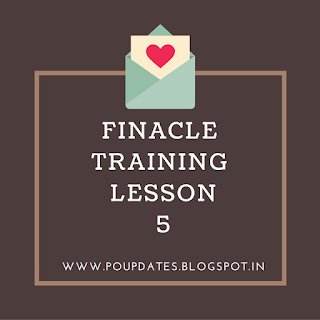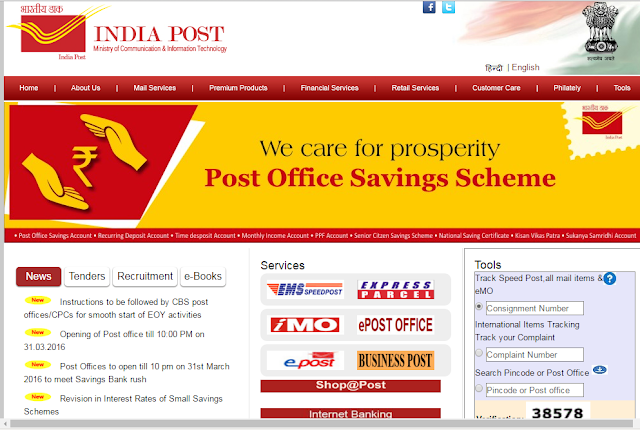Previous Lesson: Finacle Training Lesson 4 [Function]
Next Lesson: Finacle Training Lesson 6 [2 Steps, 4 States]
Recap:
In the previous lesson we
were learning about the basic terminology used in Finacle. As a part of it we
have learnt about what is Function. If you have not read the previous lesson,
please read it first and then come back and continue reading this lesson.
In today’s lesson we will
learn more about the terminology used in Finacle.
In the previous lesson we have learnt that, we instruct Finacle what to do, by
choosing appropriate function. But Function alone is not enough to complete a
transaction. Sometimes Finacle needs some additional information to fully
understand what you want to do. Let’s see this with an example.
Suppose a customer has come to your counter to make an RD Deposit by cash. Since RD Deposit can be made either by cash, or by post office SB cheque or by any bank Cheque, we need to tell finacle the mode of payment. We can tell the mode of payment by choosing appropriate option in Transaction Type. See the image below.
As we can see in the
above image we chose Function as ADD since we are doing new cash transaction.
But since RD deposit can be made by cash, POSB Cheque or bank cheque, we have
to tell Finacle whether we are making the deposit by cash POSB/Bank cheque. We
can tell this to Finacle by choosing appropriate option in Transaction Type.
· For RD Deposit by cash we choose C/NR – Cash
Deposit
· For RD Deposit by POSB/Bank Cheque we choose T/CI
– Transfer Customer Induced
· T/BI Bank Induced option is used only in extra
ordinary cases. (Bank doesn’t mean other bank. Bank means us. Bank means Post
office. We are bank.)
In this way we give
additional information about a transaction to Finacle. You will observe the
following additional options in various menus
· Function Type in CTM
· Transaction Type/Subtype in HTM, CPDTM
· Type in CPDTM
· Scheme Code/ Scheme in all account opening menus
· Product Group in MIS/TD opening and NSC/KVP issue menus.
All these additional
options are used to give additional information about a transaction to Finacle.
Various Schemes available in Finacle
As per our POSB Rules we
have several schemes which are SB, RD, MIS, TD, SCSS, SSA, NSC, KVP, NSS 87,
NSS 92 etc. In Finacle we call these as Products.
In each product there are
different types of schemes. Let’s see with an example.
Previously we used to
call SB as scheme. But in Finacle
· We call saving account with cheque book as a scheme.
· We call saving account without cheque book as a scheme.
· We call Pension account with cheque book as a scheme.
· We call pension account without cheque book as a scheme.
Similarly In TD
· We call 1 yr TD as a scheme
· We call 2 yr TD as a scheme
· We call 3 yr TD as a scheme
· We call 5 yr TD as a scheme
Hope you are getting my
point.
SB, RD, TD, MIS etc are
called as Products. Whereas, schemes have an entirely different meaning in
Finacle.
Different terms used in Finacle
Please see the below
table and you will understand the difference of terminology used in basic
terms. For example we call a customer as DEPOSITOR, in finacle we call customer
as Related Party. See the below table for more such differences and learn the
terms used in Finacle for the old terms which we were using till now.
Terms used till now
|
Terms used in Finacle
|
Account
number
|
Account
ID
|
Depositor
|
Related
Party
|
Schemes
( SB, RD, PPF etc)
|
Products
|
Customer
|
Retail
Customer
|
Passbook
View
|
Ledger
Inquiry
|
A/c
Conversion
|
A/c
Modification
|
Ac
transfer from one PO to Other PO
|
SOL
transfer
|
Post
Office
|
Service
Outlet (SOL)
|
Finacle User Interface
It is essential but not
compulsory to learn about the user interface of Finacle. People who are
rigorous internet users can skip this part of the lesson. For those people who
feel Internet as Chinese or Japanese language compulsorily read the following
part. It will be helpful not only in Finacle but also when we start using CSI
in our offices. Not only in office, even in your day to day life this knowledge
of internet will be useful.
See the image below first
then I’ll tell you in detail about what you see in the image.
The above image is a
screen shot of our India Post Website. It’s nice and colorful. There are
various items on the screen, our logo, menu, our national emblem, tracking
section of mails, important news etc. All these things are called as Elements.
These elements are all
put together to form a Website. We know that Finacle is also a website. Since
Finacle is also a website it will also have these elements. I will discuss all
the elements which are used in Finacle. Now again see the below image.
Not so colorful. But the
elements are same. Let us discuss each element in detail.
Text Field: A text field is an element in which you can enter some
data. As shown in the above all the rectangle boxes are text fields. See
in Address Line 1 and Address
Line 3 I have noted them as
Text Fields. I’m so lazy yar. That’s why I noted only two boxes as text fields.
But all the other rectangular boxes are also called as Text Fields only. We can
simply call Text field as Field.
Labels: In the above image Address Line 1 is the
Label of the Text Field which I have noted in the image. Similarly Phone Type
is the Label of the Drop down Box. Label is nothing but the name of the other
elements. For example If I tell you Pin as 500018 then you have to click
on the text field beside Pin Label on the screen and then you have to enter the
pin as 500018.
You may be thinking why
all this nonsense you are teaching man, go straight into finacle. Let me
explain. One of our respected staff who came for finacle training at my
training center did this. I told him to enter address in Address field 1. He
was clicking on the Label instead of clicking in the rectangular box beside it.
I was shocked. People have very little knowledge about internet and computers.
That’s why I’m forced to cover all this basic stuff. Moreover I'll be using
these terms very frequently in the coming lessons. So lets get used to them.
Drop Down Box : A drop down box is an element in which there will be more
than one option. In those many available options we have to choose one option.
When you click on that element, a list will drop down. Hence the name.
Radio Buttons: A radio Button is a set of buttons similar to drop down box
where we can choose only one option. Many years ago when radios were newly
used, radios had a group of buttons out of which you can only press one button
at a time. When you press the second button, the first button which is already
pressed will come up and this second button will pressed down. Here also radio
buttons will work in the same way. You can only click one button at a time.
See in the image. For
enabling internet banking there are two radio buttons Yes and No. You have to
choose either Yes or No. You cannot choose both at a time.
Radio buttons are used
when you have to choose only one option from given options.
You may be thinking drop
down boxes are also used for the same purpose. Then when should use radio
button or when should we use drop down boxes.
Radio buttons are used
when the there only 2 or 3 options. Imagine there are 100 options. It will be
very confusing when 100 buttons are present on the screen. In such cases drop
down boxes are used. When more options are there we use drop down boxes.
Check Boxes: A check box is an element which is
used when you can choose more than one option. But in finacle they never used
more than one check box at time. A check box is nothing but a small box , when
you click it, a small tick mark will come. It is used to indicate Yes or No in
our Finacle. When you check it , it means Yes, when you uncheck it, it means
No.
Buttons: I hope everybody know what a button
is. In the image, we have two buttons. 1) Submit 2) Cancel.
We have seen a lot of
buttons in Sanchay Post. Some of them are
· New Form
· Send
· Yes
· NO
· Ok etc.
In finacle we see
different kinds of buttons. I will explain some of them
Go: When you click on Go button, Finacle will show you the next
screen of the transaction which you are currently doing.
Post/Submit: When you click on Post button or Submit , it means
that your transaction is completed.
Validate: This button can be used to check whether you have
correctly filled all the fields on the screen. When you click Validate button,
Finacle will check whether everything is right. If something is missing it will
show you some error.
Clear: Clear button can be used to delete all the data which you
have entered in a screen and a fresh form will appear on the screen
Cancel: As we all know by clicking cancel, the current incomplete
transaction will be cancelled and a new screen will appear
Back: Back button will take us to the previous screen of the
transaction which you are currently doing.
So this is the basic terminology
which is used in Finacle. Don’t worry if you think I have missed something,
that something will be covered as and when necessary.
Also please keep in mind,
that if I’m not teaching about anything in Finacle, it
means that it is not necessary to learn. Your counter transactions will still
run without any problem and you can still close the counter by 04:30pm.
See you in the next
lesson.
Points to Remember:
1. Apart from Function, finacle needs
some more information to complete our transaction.
2. Finacle terminology is different from
our general terminology. But since finacle terminology is on par with global
banking terminology let’s get used to it.
3. SB, RD, TD, MIS etc are called as
Products.
4. Learn all the elements which I have
discussed in this lesson.
5. Don't
forget to follow us on
Google Plus , LIKE our Face
book page and download our android app.








